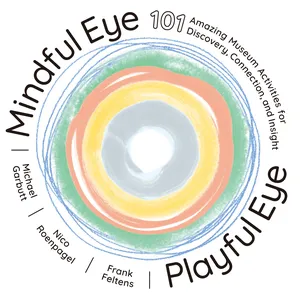Five Mindfulness Activities to Transform Your Museum Experience
Discover exciting ways to center yourself with a new book on mind-body awareness
:focal(800x602:801x603)/https://tf-cmsv2-smithsonianmag-media.s3.amazonaws.com/filer_public/db/32/db324966-45b1-4481-8794-79cd633270f3/mindful_eye_-_smithsonian_voices_cover.jpg)
Smithsonian Books' upcoming Mindful Eye, Playful Eye is a companion guide to museums and galleries as spaces to explore empowering, exciting ways of seeing and being. It’s designed to encourage discovery and deep connections—with ourselves, with others, and with the world around us.
Right now, you might be in one of the Smithsonian museums, in another museum, or, indeed, anywhere but a museum. Each of the 101 activities in the book can be experienced in all these contexts, and with any object, artifact, or artwork. Thirty of the activities showcase a diverse range of memorable exhibits from the twenty-one museums and galleries that make up the Smithsonian Institution, the world’s largest museum, education, and research complex.
What we practice in the museum can also be practiced beyond its walls. It’s our hope that the adventures of body, mind, vision, imagination, and action that visitors embark on in the museum will continue after they leave. In fact, most of the 101 practices have been designed to be experienced with any exhibit, whether it’s a Hokusai painting, a dinosaur skeleton, or a famous pair of shoes. As a result, the practices can just as easily be applied to the things we come across in everyday life. Objects will always beckon us to communicate with them in our (and their) own personal ways. Through a playful and a mindful eye, every object and image as well as every situation and relationship can be a source of discovery, connection, and insight.
Wherever you are, and whichever activities or exhibits you choose to explore, all you need is a spirit of curiosity, an openness to wonder, and a willingness to dance at the edges of habit and convention.
1. Fragrant Dreams
When you hear the words flower garden, which garden, real or imaginary, comes to mind? Close your eyes and relish its colors, fragrances, and sounds. What would it be like to experience this garden as a bird, a bee, a snail, or a cat?
/https://tf-cmsv2-smithsonianmag-media.s3.amazonaws.com/filer_public/9a/51/9a5109a0-460f-4262-869e-f1b775fd7ccd/camellia_oleifera_not_actually_in_book.jpg)
2. Fragments of Light
Close your eyes and loosely cup your hands over them. With hands still cupped, open your eyes. Even through small gaps between your fingers, the world presents complex and exciting sights. Keeping your hands loosely cupped over your eyes, turn very slowly in a circle, exploring the space around you and any exhibits it contains. When you feel ready, gently remove your hands, opening yourself up fully to the light.
/https://tf-cmsv2-smithsonianmag-media.s3.amazonaws.com/filer_public/cc/a6/cca69ba7-d0f3-46e5-8e90-2044a1a283fa/nico.jpg)
3. The Lion's Breath
The lion’s breath is a yoga breathing technique. Breathe in deeply through the nose. Then, as you exhale, make a voiceless roar from the back of your throat, scowl fiercely, and stick out your tongue as far as you can. To daunt others and detox yourself, repeat the whole cycle five times.
/https://tf-cmsv2-smithsonianmag-media.s3.amazonaws.com/filer_public/e4/c2/e4c2cdd9-3809-4d52-a19a-bbeba6bc2f44/zoo_lion_statue_-_library_of_congress.jpg)
The George F. Landegger Collection of District of Columbia Photographs in Carol M. Highsmith’s America, Library of Congress, Prints and Photographs Division
4. Bones beneath the Skin
Touch your fingers and feel the bones beneath your skin. Touch your head and feel the skull. Sense your entire skeleton. Notice how it morphs into a new shape with each movement you make. If your skeleton were to be exhibited in a museum of natural history (in sixty-five million years or so), how would you like it to be posed?
/https://tf-cmsv2-smithsonianmag-media.s3.amazonaws.com/filer_public/37/c6/37c6b748-3a6d-422b-be6a-18d451bb4227/tyrannosaurus_rex.jpg)
5. Trucker, Trilby, or Toboggan?
Abraham Lincoln wore his stovepipe hat on so many public occasions, from campaign stops to battlefield visits, that it became synonymous with the man. After his son Willie died, Lincoln had a black-silk mourning band added to its crown. On the evening in 1865 at Ford’s Theatre when Lincoln was assassinated, the hat was by his side. A hat can say a lot about a life.
A museum is planning to put on an exhibition about your life. Which single piece of headwear, real or imaginary, would best represent you?
/https://tf-cmsv2-smithsonianmag-media.s3.amazonaws.com/filer_public/26/31/26314dc6-da98-4610-9f70-31c3c8b1f05c/abraham_lincoln_hat.jpg)
Mindful Eye, Playful Eye releases from Smithsonian Books on February 27. Visit Smithsonian Books’ website to learn more about its publications and a full list of titles.
Text © 2024 by Michael Garbutt, Nico Roenpagel, and Smithsonian Institution

